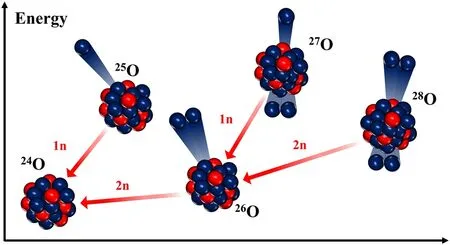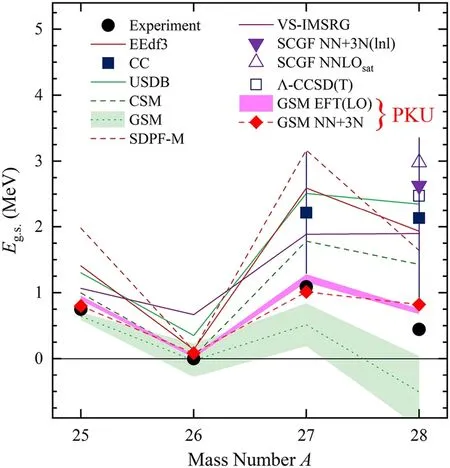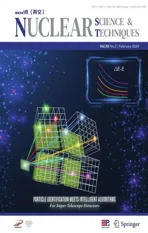Unbound 28 O, the heaviest oxygen isotope observed: a cutting-edge probe for testing nuclear models
2024-04-25JianGuoLiBaiShanHuShuangZhangFuRongXu
Jian-Guo Li · Bai-Shan Hu · Shuang Zhang · Fu-Rong Xu,3
The beyond-dripline oxygen isotopes27,28O were recently observed at RIKEN, and were found to be unbound decaying into24O by emitting neutrons.The unbound feature of the heaviest oxygen isotope,28O, provides an excellent test for stateof-the-art nuclear models.
The atomic nucleus is a self-organized quantum manybody system comprising specific numbers of protonsZand neutronsN.The nuclear force, which binds protons and neutrons together, favors equal numbers for each particle.In contrast, the long-range Coulomb repulsion discourages the accumulation of protons in the nucleus.The competition between these two forces determines thevalley of stability.However, the strong internucleon interaction binds nuclei even when many more neutrons than protons are added.ExtremeN/Zasymmetry has been observed in light-neutronrich nuclei.The particle-stable nuclei are classified as bound nuclei, which indicates that the protons and neutrons of the isotopes can be bound by nuclear forces unless radioactive decay (βdecay) transforms them into other nuclei.The existence limit of the bound isotopes for a given proton number is known as the neutron or proton dripline at the neutronrich or proton-rich edge, respectively.Beyond the driplines,nuclei may momentarily exist as resonances before emitting neutrons or protons, with very short lifetimes.
As extreme examples of particle-unstable exotic nuclei,unbound27,28O were recently produced by Kondo et al.using a proton-induced nucleon knockout with a highenergy29F beam at RIKEN [1].The heaviest oxygen isotopes,27,28O, occur beyond the neutron dripline,24O, and appear in resonances.They quickly decay into24O through26O via sequential neutron emissions.As illustrated in Fig.1, the27O and the28O undergo a 1n-2nand a 2n-2nemission process, respectively.Measurements of the emitted neutrons yielded28O at a ground-state energy of approximately±0.02(syst) MeV above that of24O with an upper limit on the resonance width of 0.7 MeV [1].Likewise,27O was obtained at an energy of approximately 1.09±0.04(stat)±0.02(syst) MeV above that of24O with an upper limit on the width of 0.18 MeV, see Fig.2.
The heaviest28O, which contains eight protons and 20 neutrons, is of special interest as it touches the ‘expected’N=20 magic shell.However, the experiment [1] supports an unclosedN=20 shell in the oxygen chain, which is consistent with previous predictions [2—7].Further experiments on a possible 2+excited state may be required to conclude the unclosed shell atN=20.In the experimental study [1],the data of the27,28O ground-state energies were compared with different calculations or predictions, showing that none of the calculations reproduced the data well.In addition to the theoretical calculations mentioned in the Nature publication [1], Gamow shell model (GSM) calculations performed by a theoretical group at Peking University (PKU) [8, 9]show excellent predictions [8, 9] compared with the data reported in Ref.[1], as shown in Fig.2.Unfortunately, the PKU predictions [8, 9] are missing in Ref.[1].

Fig.1 (Color online) Schematic of the decay processes of the particle-unstable isotopes 25-28O

Fig.2 (Color online) Experimental [1] and calculated 25-28 O groundstate (g.s.) energies with respect to 24 O.Our calculations are labeled by GSM EFT(LO) [8] and GSM NN+3N [9].Other calculations marked by EEdf3, CC, USDB, CSM, GSM, SDPF-M, VS-IMSRG,SCGF NN+3N(lnl), SCFG NNLOsat , and Λ-CCSD(T) are explained in the original paper [1]
In the published calculations [8, 9], we used the advanced GSM, which takes into account coupling to the continuum.Continuum coupling is important for weakly bound and unbound nuclei as open quantum systems, whereas the continuum effect is absent in the models mentioned in Ref.[1]except for the continuum shell model [10] and GSM with phenomenological interactions [11].In our calculations [8],a leading-order pionless effective field theory force denoted as EFT(LO) was used with only one parameter that was fitted by the binding energies of24-26O.Various regulators for the interaction were used, showing that regulator cutoffs larger than a certain value resulted in stable calculations,as shown in Fig.2, where the pink band indicates the range of calculated energies with cutoffs of Λ=356 , 390, and 436 MeV [8].In another study [9], we performed ab initio GSM calculations based on chiral two- and three-nucleon interactions, which showed that both continuum coupling and three-nucleon forces were important for weakly bound and unbound nuclei.These two studies [8, 9] yielded similar results, as shown in Fig.2, grouped by PKU labels.The predicted energies [8, 9] of27,28O were consistent with the experimental data [1] and clearly better than the other calculations reported in Ref.[1].On the other hand, both of our studies [8, 9] showed that the inclusion ofpfshell is necessary in the calculations forsd-shell weakly bound and unbound nuclei.Unbound27,28O have significantpfcomponents that may be associated with the disappearance or weakening of theN=20 shell closure, as claimed in Ref.[1].Based on our calculated energies and one-body densities, we predicted [8] that28O should undergo four-neutron decay, more specifically a 2n-2nemission process through26O, which is consistent with experiments [1].The observation of28O has opened up a new window to probe into the elaborate internucleon interplay under extreme conditions.
杂志排行
Nuclear Science and Techniques的其它文章
- Measurement of the neutron-induced total cross sections of natPb from 0.3 eV to 20 MeV on the Back-n at CSNS
- Nuclear charge radius predictions by kernel ridge regression with odd-even effects
- Development of CONTHAC-3D and hydrogen distribution analysis of HPR1000
- Total ionizing dose effect modeling method for CMOS digital-integrated circuit
- A fast forward computational method for nuclear measurement using volumetric detection constraints
- Artificial neural network-based method for discriminating Compton scattering events in high-purity germanium γ-ray spectrometer
